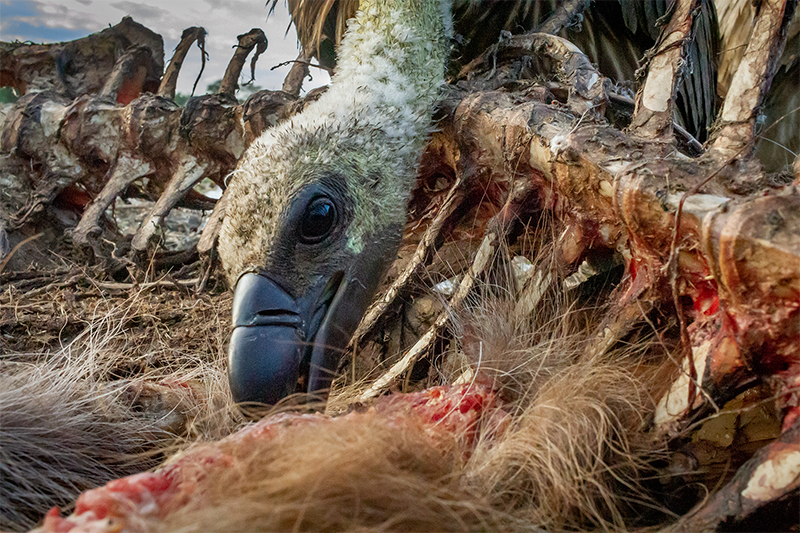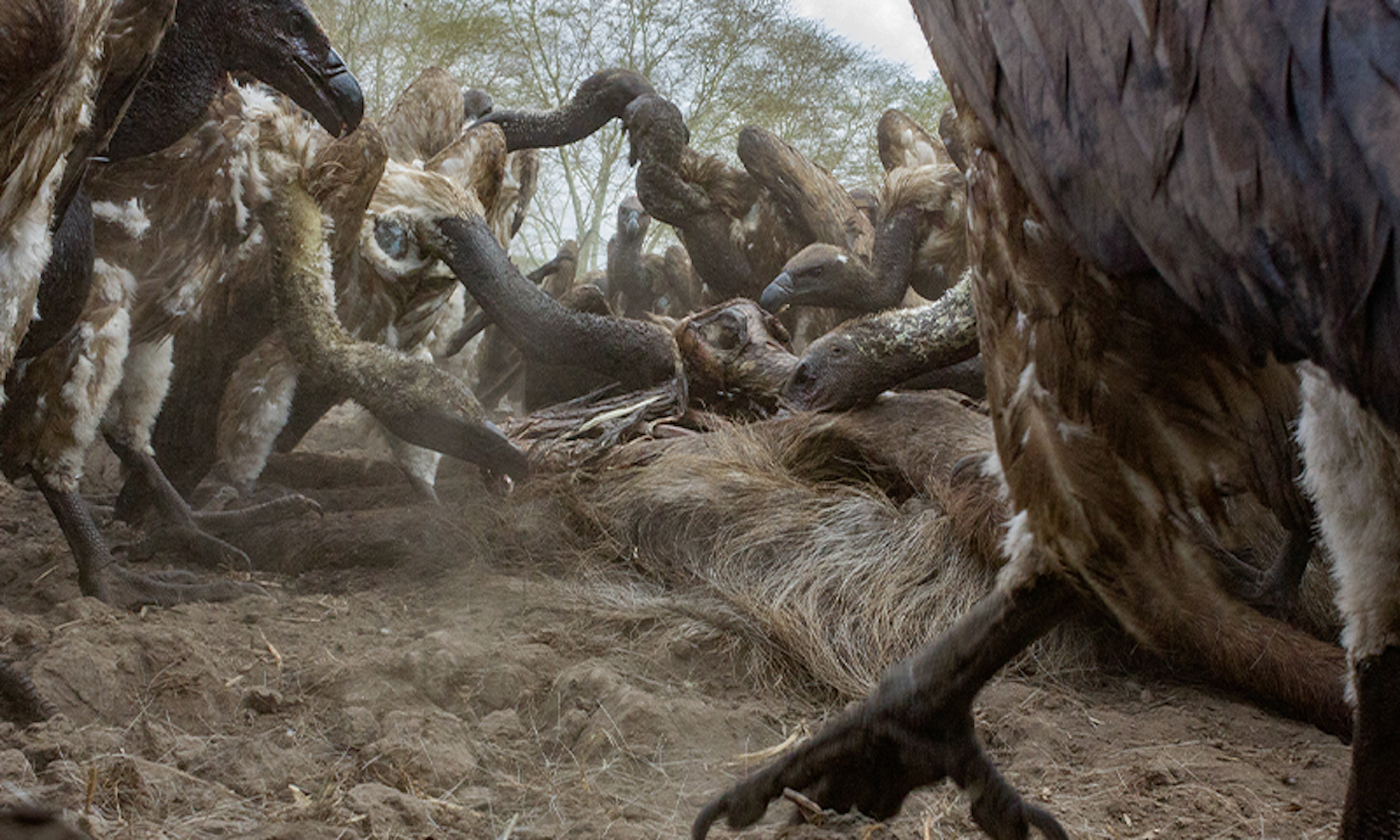
In his poem “Vultures,” the Nigerian writer Chinua Achebe makes the scavenger bird a metaphor for the evil of a concentration camp.
Yesterday they picked
the eyes of a swollen
corpse in a water-logged
trench and ate the
things in its bowel.
Vultures are almost never described affectionately in literature. Instead, they serve as grotesque symbols of the hollowness of death, of exploitation, of benefits gained only by the misfortune of others. In short, vultures give us the ick. And that feeling of general disgust sometimes affects how people think about vulture research and conservation.
But no matter how we collectively feel about vultures, researchers are sure we’re going to miss them when they’re gone. Despite their gross reputation, vultures serve as the janitors of the bush.
Gorongosa, a haven for vultures, has a smorgasbord of options for the hungry scavenger.
People often think that vultures transmit disease since they feed on carrion, but the opposite is true. If a cow or an antelope should die in a forest or on a savanna, vultures swoop in, pick clean the bones, and then eat the bones, too, all in a couple of hours, says Ethiopian biologist Alazar Daka Ruffo, a consultant for Bird Life International. Even if that cow died of anthrax or hoof-and-mouth, the vulture could digest it and emerge unscathed. Vultures perform the critical function of waste removal and disposal of carcasses that might otherwise spread bacteria and pathogens. At abattoirs near Addis Ababa, where Ruffo studies vultures, the birds feed on offal and viscera. “They are employees who aren’t paid a salary,” Ruffo says jokingly.
But vulture populations across Africa are crashing. Scientists estimate that populations of several species of vultures in Africa declined by an average of 62 percent over the past 30 years.1 Among them, the white-headed vulture is a critically endangered species, with only about 5,500 individuals left in the wild.
Many vulture species are social animals—picture a kettle of vultures sharing a meal of a buffalo carcass, joining one another for a snack, and nesting together as a colony. But the rare, white-headed vulture is solitary, almost shy. It prefers to fly and feed in smaller groups, and a brooding couple will often build a nest only for itself and tuck it away on the top of a baobab tree.
“They build a nest cup lined with grasses, and then they reinforce it along the edges with a thick ring of sticks,” says Rebecca Bishop, a Boise State University graduate student who has been on the hunt for these solitary nests in Mozambique’s Gorongosa National Park for the past couple of years. “White-headed vultures are so rare and understudied that we still lack basic natural history knowledge pertaining to the species, which is unusual in 2023,” she says. “So, we’ve got a gap where we don’t completely understand a species in drastic decline.”

That’s where her research on the breeding ecology comes in. By surveying nests and their locations in Gorongosa and working to characterize them, Bishop and other researchers are creating the baseline data needed to follow the species both in the park and in other ecosystems.
Given how rare white-headed vultures are, Bishop was surprised to find so many of their nests hidden away in Gorongosa’s plentiful baobab trees. “My first season, I actually went and collected data on 13 white-headed nests,” she says. When she came back the following year, in 2022, she used a drone to get a better view of the canopy and found even more. “Just the fact that we’ve got such a high density of nesting white-headed vultures is really impressive,” says Bishop. “I went to a conference in Zimbabwe last fall and talked to other vulture researchers from Africa. In West Africa, specifically, they note maybe two white-headed vulture nests in some national parks.”
After Mozambique’s civil war (1977-1992), vulture researchers like Bishop might not have seen many vultures. The park had been a zone of intense hunting, and the populations of waterbuck, elephants, and baboons—all good vulture food—were in sharp decline. But after nearly 30 years of rest and restoration, big mammal populations have started to rebound. Gorongosa’s latest animal census found more than 60,000 waterbuck and nearly 10,000 impala, so the park has a smorgasbord of options for a hungry scavenger bird.
Vultures have a stomach of steel and can digest botulism and anthrax with no issues.
“Gorongosa seems like a stronghold for a few different [vulture] species,” says Greg Kaltenecker, director of Boise State’s Intermountain Bird Observatory, who has also been studying vultures in Gorongosa for several years. The park is a safe haven not only for the shy white-headed vultures, but also for the more well-studied and more common white-backed vulture, which is also critically endangered. White-backed nesting pairs in the park number in the hundreds.
Bishop and Kaltenecker credit the vultures’ success in the park to Gorongosa’s biodiversity, including its abundant baobab trees, and its dynamism as a system. In isolation, if they were the only scavengers, vultures wouldn’t thrive. Vultures have trouble tearing open tough waterbuck or elephant carcasses on their own, so they sometimes need a little help from a larger predator or scavenger. For vultures, Gorongosa’s recent re-introductions of hyenas and side-striped jackals is good news. “As those carnivores increase in numbers and make that food more available, vultures are going to be able to eat and scavenge and raise chicks and thrive,” Bishop says.
In previous studies, Boise State researchers helped tag some of these two vulture species, so they could track their movements. White-headed vultures stay mostly within the confines of the park and the buffer zone around it “It’s uncanny; they seem to know right where the park boundaries are with a few exceptions,” Kaltenecker says. “Protected areas represent important habitat features the vultures are keying in on.” Although white-backed vultures nest in the park, they can forage thousands of kilometers away, crossing Gorongosa’s borders and, often, the borders of Mozambique itself.
The Boise State Intermountain Bird Observatory has been researching vultures in Gorongosa for nearly 10 years, a collaboration between faculty members and masters’ students from the United States and Mozambique. So far, their discoveries included the white-headed vultures’ apparent awareness that they are safer in the confines of the park, and the vast amplitudes of the feeding forays of white-backed vultures. Bishop’s research about nest ecology—identifying and characterizing the nests of different species—is significant because the information she has produced can help forecast where other healthy breeding populations might occur, within the park and outside of it. And discovering so many in the park when the numbers of both species are critically low across the continent is a good indication of a healthy population.
Hunters poison vultures, nature’s narcs, to keep their circling group from alerting authorities.
But the threats beyond the park are many. The transformation of forests or grasslands into farmland and urban areas means vultures have more difficulty finding their favorite nesting trees. Power lines and windmills pose a critical threat to the birds whose superpower is to focus on the ground below but who have trouble seeing dangers in front of them2; vultures regularly get electrocuted on power lines and collide with the blades of a wind turbine with fatal results. Although vultures have a stomach of steel—they have a gastric acid level that’s nearly the same as pure hydrochloric acid,3 and can digest botulism, anthrax, and salmonella with no issues—they are felled by anti-inflammatory drugs that are often used on livestock.4 In addition, across the continent, vultures are sometimes targeted for ritual use.5, 6
Domingas Matlombe, who finished her master’s in Gorongosa’s conservation biology program in 2022, and collaborated with researchers from Boise State, also found that some people in the rural communities near Gorongosa are using vulture parts for traditional medicine. Many healers told her that hunters bring them already dead animals, but she was skeptical. “We can’t assume the hunters are always so lucky as to find dead animals,” she says. “Maybe the hunters know the spots the vultures occur, and they are killing vultures in order to sell them.”
Most experts say poisoning is the single largest driver of the decline in vultures across the continent. “Often, it’s not that they are targeted directly for extirpation, but they become the secondary victims,” says André Botha, program manager of Vultures for Africa at the Endangered Wildlife Trust in South Africa. If a community has a problem with an animal, say, an elephant or a lion, they might poison it. Once it dies, vultures swoop in for a tasty treat and are unintentionally poisoned as well. “We’ve had incidents where literally hundreds of vultures have been killed feeding on a single poisoned elephant carcass.”
In places where criminal groups hunt elephants to harvest their tusks for illegal trade in ivory, or hunt other animals without authorization, hunters might deliberately poison vultures, nature’s narcs, to keep their circling group from alerting authorities. Botha says both conservationists and researchers need to adopt a regional approach to form policies to protect the continent’s remaining vultures. Research like Matlombe’s on the social perceptions of vultures, which delves into the religious or belief use of vulture parts that is common in some corners of Africa, might help bring in more people into a regional or continent-wide plan on vulture conservation.
Vultures, though, are hard animals to champion in a marketplace of small and large donors who are mostly interested in charismatic megafauna. Kaltenecker tries to explain to donors that vultures are more than just gross bogeymen; they are key actors in the ecosystems they inhabit, the trash collectors of the natural world. As Gorongosa, a model of wildlife recovery, shows, vultures have a lot of work to do. ![]()
Jori Lewis writes narrative nonfiction that explores how people interact with their environments. Her reports and essays have been published in The Atlantic, Orion, and Emergence Magazine, among others. She is a senior editor of Adi Magazine, a literary magazine of global politics. In 2022, she published her first book, Slaves for Peanuts: A Story of Conquest, Liberation, and a Crop That Changed History, winner of a 2023 James Beard Media Award.
The Nautilus Gorongosa series is published in partnership with the Howard Hughes Medical Institute’s Science and Educational Media Group.
Lead photo by Piotr Naskrecki
Prefer to listen?
References
1. Safford, R., et al. Vulture conservation: The case for urgent action. Bird Conservation International 29, 1–9 (2019).
2. Martin, G.R., Portugal, S.J., & Murn, C.P. Visual fields, foraging, and collision vulnerability in Gyps vultures. International Journal of Avian Science 154, 626-631 (2012).
3. Houston, D.C. & Cooper, J.E. The digestive tract of the white-back griffon vulture and its role in disease transmission among wild ungulates. Journal of Wildlife Diseases 11, 306-313 (1975).
4. Krüger, S.C., et al. Old world vultures reflect effects of environmental pollutants through human encroachment. Environmental Toxicology and Chemistry 41, 1586-1603 (2022).
5. Manqele, N.S., Seiler, S.A.J., & Downs, C.T. The ethnomedicinal use of vultures by traditional health practitioners in KwaZulu-Natal, South Africa. Journal of Ornithology (2023).
6. Saidu, Y. & Buij, R. Traditional medicine trade in vulture parts in northern Nigeria. Vulture News 65 (2013).
































